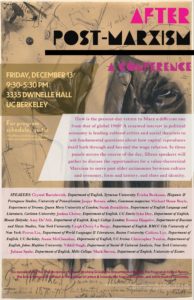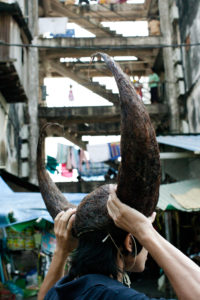Talk That Talk: Shakespeare’s Venus and Adonis and the Seductions of a Form
by Matthew Hunter
The essay begins:
 England’s Parnassus has long been studied for what it includes. Published in 1600, the printed commonplace book culls together passages from Philip Sidney, Edmund Spenser, Christopher Marlowe, William Shakespeare, and other lodestars of its fin de siècle moment. The inclusion of such vernacular authors sets England’s Parnassus apart from the commonplace books that came before it, which anthologized only writers of classical antiquity. It also aligns the volume with more recently printed commonplace books, like Francis Meres’s Palladis Tamia (1598) and John Bodenham’s Bel-vedere, or The Garden of the Muses (1600), which collectively ushered in what Zachary Lesser and Peter Stallybrass have called “a novel conception of commonplacing,” whereby “‘Moderne and extent Poets,’ who wrote in the culturally and geographically marginal vernacular of English, [are treated] as suitable authorities on which to base an entire commonplace book.” But England’s Parnassus is just as notable for what it leaves out. When the coy Adonis, in Shakespeare’s Venus and Adonis, resists the advances of the goddess of love, he protests by urging her to “Call it not love, since love to heaven is fled, / Since sweating lust on earth usurped the name.” It is just one of the many aphorisms from the poem that Robert Allott, the book’s editor, excerpts. But that is not quite how the passage goes in England’s Parnassus. “—Love to heaven is fled,” it reads, “Since sweating lust on earth usurpt the name.” As a heavy dash effaces the metalanguage that begins Adonis’s pronouncement, England’s Parnassus offers an early modern example of the transcultural tendency, documented by Greg Urban, for transcriptions to delete the metalanguage that marks them as transcribable in the first place, “as if the metadiscursive portions of the discourse were invisible (or inaudible) and yet capable of exercising an effect.”
England’s Parnassus has long been studied for what it includes. Published in 1600, the printed commonplace book culls together passages from Philip Sidney, Edmund Spenser, Christopher Marlowe, William Shakespeare, and other lodestars of its fin de siècle moment. The inclusion of such vernacular authors sets England’s Parnassus apart from the commonplace books that came before it, which anthologized only writers of classical antiquity. It also aligns the volume with more recently printed commonplace books, like Francis Meres’s Palladis Tamia (1598) and John Bodenham’s Bel-vedere, or The Garden of the Muses (1600), which collectively ushered in what Zachary Lesser and Peter Stallybrass have called “a novel conception of commonplacing,” whereby “‘Moderne and extent Poets,’ who wrote in the culturally and geographically marginal vernacular of English, [are treated] as suitable authorities on which to base an entire commonplace book.” But England’s Parnassus is just as notable for what it leaves out. When the coy Adonis, in Shakespeare’s Venus and Adonis, resists the advances of the goddess of love, he protests by urging her to “Call it not love, since love to heaven is fled, / Since sweating lust on earth usurped the name.” It is just one of the many aphorisms from the poem that Robert Allott, the book’s editor, excerpts. But that is not quite how the passage goes in England’s Parnassus. “—Love to heaven is fled,” it reads, “Since sweating lust on earth usurpt the name.” As a heavy dash effaces the metalanguage that begins Adonis’s pronouncement, England’s Parnassus offers an early modern example of the transcultural tendency, documented by Greg Urban, for transcriptions to delete the metalanguage that marks them as transcribable in the first place, “as if the metadiscursive portions of the discourse were invisible (or inaudible) and yet capable of exercising an effect.”
So far as Adonis’s aphorism is concerned, Urban’s parenthesis is crucial. An imperative to speak that is itself spoken, Adonis’s metadiscursive “call” is a particularly self-conscious reminder that the many aphorisms of Venus and Adonis are part of an extended conversational exchange. In fact, although it is rife with passages of lush and alluring description, the epyllion resembles nothing so much as a dialogue, since its primary narrative action comes from the heated discourse that unites its two protagonists. Shakespeare’s most outrageously successful poem, in other words, is also his chattiest, and the aphorism is its principle form of talk. By deleting Shakespeare’s metalanguage, however, England’s Parnassus deletes the words that give Shakespeare’s aphorisms their situated, conversational force. The excision would seem to have set a standard for the criticism that has flourished in its wake. While scholars have been rightly attentive to the place of Venus and Adonis in early modern sexualities, or in the formation of Shakespeare’s durable career, or even in the history of rhetoric, the poem’s remarkably dialogic texture would seem to have been taken for granted.
This essay reads with Allott’s commonplace book and also against it. It returns Shakespeare’s aphorisms to their most significant context, the amorous conversations of Venus and Adonis, in order to show how the form flourishes in that poem as a potent and seductive form of talk. In this respect, Venus and Adonis does not simply reflect early modern attitudes toward the aphorism; it actively shapes them. The poem’s outsized popularity—it was reprinted ten times during Shakespeare’s lifetime—came in no small part from the way readers reproduced its aphorisms in their own conversations, in just the way that its protagonists encouraged: that is, erotically. Like other works from the early modern period, Venus and Adonis celebrates the aphorism as a model of conversational competence, but it takes that celebration a step further by turning the budding early modern art of conversation into just the erotic practice that, as Jeffrey Masten has recently reminded us, its etymology implies.
This essay follows upon Masten’s investigation into the multiple early modern meanings of “conversation:” “interchange of thoughts and words,” “intimacy,” “sexual intercourse,” and “conversion.” But it departs from his avowedly philological approach in order to consider not iterations of the word “conversation” but one especially erotic (and especially popular) enactment of conversation. By drawing together talk and desire, using the former to illuminate the latter, I extend to early modern studies the methodologies and critical frameworks of a field that has come to be called “language-in-use.” Language-in-use treats as its foundation what Charles Sanders Peirce called the indexical—or pragmatic—nature of language: the way words are saturated with meaning through the situated occasion of their use, as the empty pronoun “I” most readily demonstrates. Resisting literary analyses that, in the words of Michael Lucey and Thomas McEnaney, “seem to arise out of the encounter between a critic’s intellect and a text understood as a thing to be contemplated by that intellect,” language-in-use studies “how a work’s form, how the forming of a work, connects it (indexically) to the social world from which it emerges and also to the social worlds through which it circulates.” At the same time, the indexicality of language demands our consideration not only of how words absorb meanings from the contexts of their delivery, like a sponge in water, but also of how language meta-indexically—or metapragmatically—construes the very occasion of its unfolding.
The aphorism is at once indexical and constitutive of social relations. In Shakespeare’s moment as in ours, it is a form most readily associated with wisdom, learning, and erudition. We might think of these qualities as the aphorism’s pragmatic effect, the intersubjective meaning that the form communicates without making explicit in the moment of its utterance. Yet it is worth stressing from the outset that such meanings are in no way inherent or unvarying. As Asif Agha observes in an important treatment of language and social formations, “Cultural value is not a static property of things or people but a precipitate of sociohistorically locatable practices.” Any form is a relay of social relations, but if those relations ever seem essential or fixed—a property internal to the form—that is only because of how durably the form has been saturated with cultural value through reflexive and historically contingent occasions of use. In other words, the pragmatic effects of a form—didacticism, say, or wisdom—are metapragmatically achieved. Venus and Adonis is particularly illustrative of this achievement because it works to construe the social effects of the aphorism as erotic effects. Not only does the poem enlist the aphorism in seductive moments of talk, but it also metapragmatically accords the aphorism a metapragmatic effect of its own: in use, the aphorism frames the occasion of talk as just the erotic experience that Masten describes.
That sexual power comes from the aphorism’s two-pronged manipulation of conversation and contact. First, the aphorism indexes a speaker’s attention to—and respect for—talk as a collaborative undertaking. The form’s brevity projects a speaker who is not so caught up in his emotions, his anxieties, or his own words as to lose sight of the others to whom he speaks and from whom he solicits a reply. In this respect, the aphorism is a form of mastery. Its pith is the expression and the performative accomplishment of a presence of mind—call it composure—in the midst of the most demanding of social tasks. For Shakespeare’s Venus and the many readers who quoted her, seduction is one particularly demanding such task; it rouses the nerves, excites the body, and risks a humiliating loss of face. The aphorism offers a counterbalance to such challenges. It projects a speaker whose bodily excitations are held in check, who is assured in speech, and who is, accordingly, entirely present.
That presence turns the speaker into an erotic object, a figure who is fully open to his addressee. Yet the eroticism of the aphorism is just as much an effect of its curious self-effacement. As a pointedly brief expression of universal truth, the form announces that “fresh talk has momentarily ceased,” as Erving Goffman puts it, and “an anonymous authority wider and different from ourselves is suddenly being invoked.” The aphorism thus makes its speaker both charismatically present and alluringly, even seductively, withholding. The effect of that opacity is to draw us in. In projecting a speaker who is as absent as he is present, who is as withholding as he is composed, the aphorism issues an unspoken invitation, soliciting further contact from the speakers to whom it is addressed. This silent invitation brims at the heart of even modern-day aphorisms—think of the way pithy, seemingly profound declarations create speakers we want to hear more from—but in Venus and Adonis, it is pointedly sexualized. The invitation to talk, in this poem, is also an invitation to sex.
By framing the speaker as an erotic object, the aphorism simultaneously frames the conversation as itself an erotic encounter. This is the second, corollary effect of the aphorism, as indeed it is of any speech act meant to frame its speaker as a sexual object, since a definition of the self is always also a definition of the situation in which the self speaks. Yet what properly distinguishes the aphorisms of Venus and Adonis is the fantasy the poem generates about their use. As a poeticized conversation in which both parties trade aphorism for aphorism, Venus and Adonis unfolds as a script for how conversation might go, and, according to this script, the aphorism’s seductive power is to invite the addressee to respond with an aphorism of his or her own, as Adonis does when Venus courts him, so that the occasion of talk becomes a back-and-forth exchange in which each reply functions as part of a larger, unified whole. One word for such pointed exchange is stichomythia. Familiar to scholars of classical and Renaissance drama, stichomythia names idealistically formalized repartee in which alternate lines of a versified dialogue are delivered in rapid succession, drawing speakers into intimate and supercharged contact, sometimes even against their will. Such formalized repartee enjoys its fair share of treatment on the early modern stage. We might say that any instance of stichomythia produces a fantasy of how talk might go. I focus on Venus and Adonis, however, because it is the period’s most sustained attempt to embrace the eroticism that so often only simmers beneath the surface of aphoristic repartee. The aphorism is such an erotic form of talk, the poem shows, because it invites another to join in the collaborative, pleasurable improvisation of form. Sex is one of those collaborative, improvised forms. Talk is another. Continue reading …
In this essay Matthew Hunter draws upon the work of Erving Goffman and Michael Silverstein to read Shakespeare’s first poem as a guide to mastering the burgeoning early modern art of conversation. The epyllion follows the conversation manuals of its day in embracing the aphorism as a charismatic form of talk, but it departs from its precedents in attributing to the aphorism an overtly erotic force. By according to the aphorism the power to turn conversation into an erotic encounter, Venus and Adonis elaborates its period’s most seductive fantasy of talk.
 MATTHEW HUNTER is Assistant Professor of English at Texas Tech University. He has just completed the manuscript of his first book, The Pursuit of Style in Early Modern Drama, which studies the panoply of styles that early modern plays codified as scripts for interacting in a newly public world.
MATTHEW HUNTER is Assistant Professor of English at Texas Tech University. He has just completed the manuscript of his first book, The Pursuit of Style in Early Modern Drama, which studies the panoply of styles that early modern plays codified as scripts for interacting in a newly public world.

 How is the present-day return to Marx a different one from that of global 1968? A renewed interest in political economy is leading cultural critics and social theorists to ask fundamental questions about how capital reproduces itself both through and beyond the wage relation: how it makes and unmakes classes across modes of production, creates surplus and disposable populations that are racialized and gendered, and requires both unexploited and waste spaces, in its quest to produce value.
How is the present-day return to Marx a different one from that of global 1968? A renewed interest in political economy is leading cultural critics and social theorists to ask fundamental questions about how capital reproduces itself both through and beyond the wage relation: how it makes and unmakes classes across modes of production, creates surplus and disposable populations that are racialized and gendered, and requires both unexploited and waste spaces, in its quest to produce value. In 2011, artist Khvay Samnang offered “piggyback” rides to residents and visitors of the White Building in Phnom Penh, Cambodia, as part of his performance piece, Samnang Cow Taxi. Titled colloquially with his given name, it was a humble undertaking. Khvay wore handmade cow horns (fig. 1) and, despite his svelte frame, humorously carried people on his back as if he were a robust workhorse. Evoking the water buffalo, a laboring animal crucial to Cambodian agricultural practices, seemed an odd choice for someone ferrying people around the more urban setting of the White Building. Moreover, the taxi ride seemed to grant a touristic gaze for nonresidents of the dilapidated public housing complex. Yet the physical intimacy of the gesture, as well as the slowness and toil of it, lent a critical edge to the playful jaunt around the famous white apartment structure, transformed into a muddy gray from decades of neglect. The White Building was erected in 1963 as a modernist, utopian experiment in public housing. It was created soon after Cambodia’s independence in 1953 as part of a socially optimistic, homegrown wave of New Khmer Architecture, and it was intended to house civil servants and municipal workers. After the devastating Khmer Rouge regime collapsed in 1979, many returned to the city in need of housing, and the modest apartments were repopulated with dancers, musicians, artists, and filmmakers. Khvay’s own practice has been deeply indebted to the site and people of the White Building, and his slow, caring, arduous gesture highlighted a community of residents who, like the building itself, have been historically subject to state neglect, inattention, and habitual violence.
In 2011, artist Khvay Samnang offered “piggyback” rides to residents and visitors of the White Building in Phnom Penh, Cambodia, as part of his performance piece, Samnang Cow Taxi. Titled colloquially with his given name, it was a humble undertaking. Khvay wore handmade cow horns (fig. 1) and, despite his svelte frame, humorously carried people on his back as if he were a robust workhorse. Evoking the water buffalo, a laboring animal crucial to Cambodian agricultural practices, seemed an odd choice for someone ferrying people around the more urban setting of the White Building. Moreover, the taxi ride seemed to grant a touristic gaze for nonresidents of the dilapidated public housing complex. Yet the physical intimacy of the gesture, as well as the slowness and toil of it, lent a critical edge to the playful jaunt around the famous white apartment structure, transformed into a muddy gray from decades of neglect. The White Building was erected in 1963 as a modernist, utopian experiment in public housing. It was created soon after Cambodia’s independence in 1953 as part of a socially optimistic, homegrown wave of New Khmer Architecture, and it was intended to house civil servants and municipal workers. After the devastating Khmer Rouge regime collapsed in 1979, many returned to the city in need of housing, and the modest apartments were repopulated with dancers, musicians, artists, and filmmakers. Khvay’s own practice has been deeply indebted to the site and people of the White Building, and his slow, caring, arduous gesture highlighted a community of residents who, like the building itself, have been historically subject to state neglect, inattention, and habitual violence.
